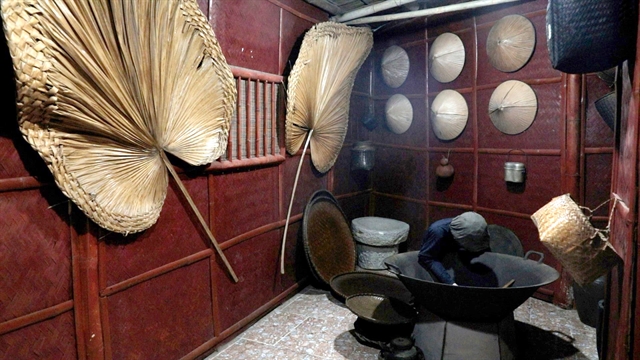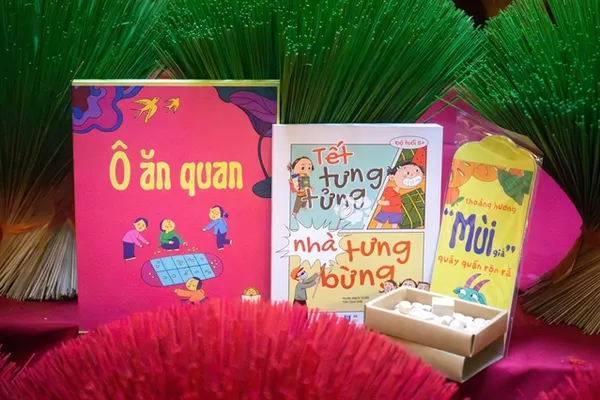 Life & Style
Life & Style

Trần Khánh An
Nestled in the mountains of Thái Nguyên Province, Tân Cương Commune is renowned as the home of the 'most fragrant tea' in the country.
The wonderful taste of Tân Cương tea is sure to please even the pickiest tea connoisseurs.
According to Đào Thanh Hảo, CEO of Hảo Đạt Cooperative, the climate and soil in the Tân Cương area play a decisive role in creating the quality of the tea.
“It receives nourishment from the Công River and Núi Cốc Lake, while the Tam Đảo mountain range serves as a shield to keep moisture to stay in Tân Cương's land,” she said.
The cultivation and processing techniques of the local people also contribute to the tea's flavour.
100-year heritage
 |
| Tân Cương Tea Culture Space reconstructs how local people processed tea in the 1900s. VNS Photo Trần Khánh An |
The tea cultivation and processing method in Tân Cương dates back to the early 1900s. Đội Năm (born Vũ Văn Hiệt) encouraged local people to reclaim wasteland, brought back a small-leaf tea variety from the midland region, and instructed people to grow and process it.
Tân Cương tea's quality has developed and become renowned, and even won first prize at the Hà Nội trade fair in 1935, and other awards since then.
Although local farmers could leverage new technology in tea processing, they still preserve the 100-year-old method of their ancestors. Some cooperatives still retain traditional ways of enhancing the tea’s profile in some product lines.
“The best time to harvest tea buds is in early morning. After tea leaves are plucked by hand, we can heat them immediately, thus deactivating their oxidative enzymes to keep the flavour of the tea,” said farmer Nguyễn Thị Quyên, 53, who has 30 years of experience in tea planting and processing.
“The traditional way of heating fresh tea leaves in a large iron pan is special in that the worker only uses his/her own hands to stir the leaves and feel all the temperatures to adjust the fire to create distinctive flavour and aroma for the tea,” she said.
Nowadays with advanced technology in a tea factory, this process is often done by roasting in a rolling drum.
 |
| Workers at the Hảo Đạt Cooperative still retain the traditional processing technique of Tân Cương people. VNS Photo Trần Khánh An |
Thái Nguyên has over recent years come up with multiple initiatives to help businesses, cooperatives and farmer households who grow tea to preserve and expand the brand name of Tân Cương speciality tea.
They have also established "Tân Cương Tea Culture Space", aiming to preserve many artefacts and documents about the history and development of tea cultivation in the commune.
In 2023, Tân Cương's tea cultivation and processing was recognised as a national intangible heritage.
“The recognition affirms the brand name of Tân Cương tea not only in Thái Nguyên but also nationally,” said Nguyễn Thị Thùy Linh, vice chairwoman of Tân Cương People's Committee [commune authority].
“This demonstrates the efforts of the Tân Cương people to preserve and develop tea cultivation and processing methods over the past hundred years.”
Tourism potential
 |
| Visitors can freely enjoy the awe-inspiring landscapes of immense tea hills, as well as explore the tea harvest and process of Tân Cương speciality tea. VNA/VNS Photo Thanh Tùng |
Tân Cương's tea planting tradition has significant potential for tea-related tourism to thrive. Thái Nguyên recognises Tân Cương Commune as a community-based tourism destination.
The location has grown in popularity as a travel destination because of its stunning tea hills, traditional stilt houses, and wide range of cultural activities. Tourists can experience tea harvesting and processing, and enjoy tea while listening to the history of Tân Cương tea farming.
“Currently, we do not charge fees for such activities. We hope that serving flavoursome tea to visitors at our Tea Culture Space will help spread the word about Tân Cương,” CEO Hảo said.
Vũ Thị Uyên, a lecturer in tourism at the Hà Nội University of Culture, said that each locality needed to find its own cultural characteristics when developing tourism.
“Tân Cương speciality tea is highly recommended for its exceptional aroma, but it also has a rich tapestry of cultural elements. The goal is not just about selling tea, but about sharing the culture and stories of Tân Cương tea. By doing so, the Tân Cương tea brand can be elevated further.” VNS




